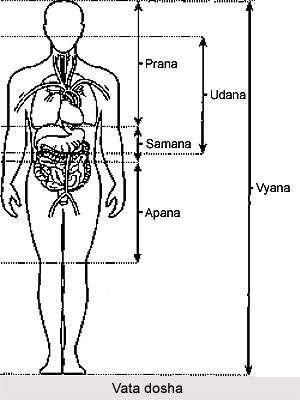 The five types of Vata dosha are: prana, udana, samana, apana and vyana. Prana is also known as air of respiration. It also means `life` which is the first air of the universe and of the body. Although located in the body between the diaphragm and throat, it pervades the region of the heart, chest, face and brain. Prana helps in chewing and swallowing of food and provides immediate nourishment to all vital tissues of the body. The system is being rejuvenated through inhalation, exhalation and timely preservation. The main function of prana is extracting life from the digested food and diffusing it into all of the tissues in the body.
The five types of Vata dosha are: prana, udana, samana, apana and vyana. Prana is also known as air of respiration. It also means `life` which is the first air of the universe and of the body. Although located in the body between the diaphragm and throat, it pervades the region of the heart, chest, face and brain. Prana helps in chewing and swallowing of food and provides immediate nourishment to all vital tissues of the body. The system is being rejuvenated through inhalation, exhalation and timely preservation. The main function of prana is extracting life from the digested food and diffusing it into all of the tissues in the body.
Prana facilitates all movement in and out of the body. It moves in the region of the heart thereby causing it to beat. The food is carried by it through the oesophagus into the stomach. It sustains the heart, arteries, veins, senses, and our intelligence.
If prana cannot function properly life is threatened. It results in respiratory ailments such as bronchitis and asthma, heart ailments and the urge to vomit. Udana is the second type of Vata which means rising of air that flows upward from the navel through the lung and into the throat and nose. It is also recognized as the air of ejection, it provides the vocal powers and clarity of sense perceptions. It preserves the natural forces of the body like the strength of will and capacity for effort.
Udana keeps track of the number of breaths we use. It also has the capacity to preserve memory, both experiential and cognitive. Harm to udana can result in memory loss, impaired speech, heaviness in the head, deep-seated fears, and a shortened life span.
Samana, the third air of Vata, is located between the diaphragm and navel. It aids the movement of food through the stomach and small intestines by stimulating the production of gastric juices and digestive enzymes. It also helps in the assimilation of nutrients that have been extracted from our food. It is the moving force that transports these nutrients to the various tissue elements and discharges wastes into the colon. When samana is disturbed, it can cause mucus accumulation in the stomach called `ama`, as well as indigestion, poor assimilation and diarrhoea.
Apana is the fourth air of Vata that is located in the colon and the organs of the pelvic region. It is also known as the air of elimination. Its major function is to relieve the body of feces, urine, flatus, semen and menstrual waste. Its down ward pressure maintains the foetus position and the flow of its eventual birth. Apana is the most dominant of the five airs as it is situated in Vata`s primary location. Apana maintains the delayed nutrition of prana in the organism. Any harm to apana causes diseases of the bladder, anus, testicles, uterus, menstrual problems and persistent urinary diseases, including diabetes.
Vyana is the final air of the Vata and is located in the heart. It diffuses the energy that is derived from food and breath throughout the entire organism. It is circulatory in nature. It functions in the body`s circulation channels like the blood vessels, to transport nutritive juices and blood throughout the body. It also carries sweat from the glands to the skin and is the force behind bodily expressions like yawning and blinking. When there is a malfunctioning in Vyana skin becomes dry and causes other body extremities. Circulation becomes poor.





